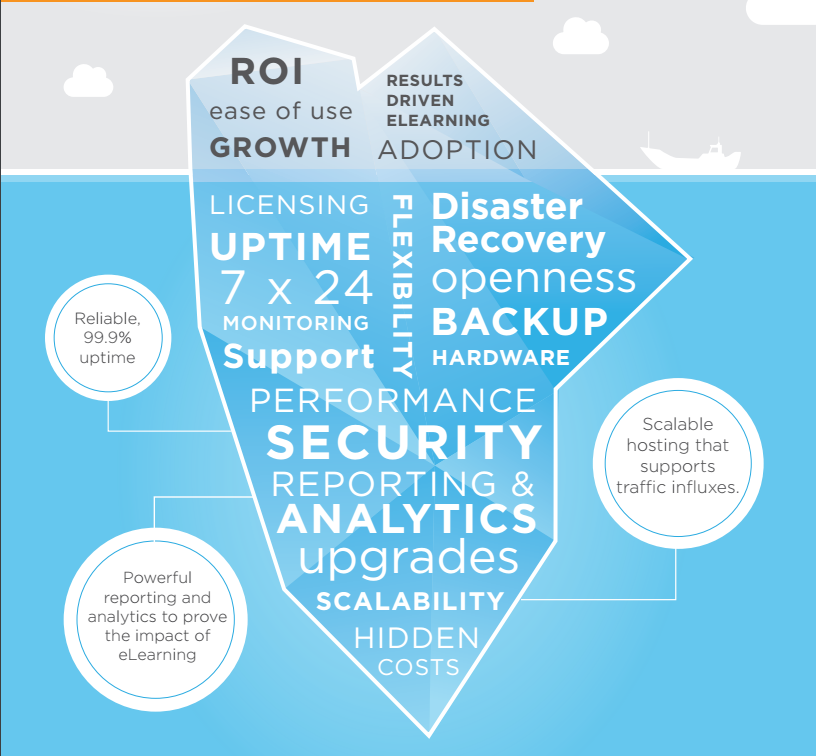The iceberg analogy is one we often use when discussing implementations. Buyers spend a great deal of time looking for the LMS features that they want, but rarely stop to think about the aspects under the surface - like training, or support. These “hidden” aspects are important to consider and to know upfront when assessing a potential LMS because they give you an understanding of where your money is going.
Services
1. LMS Support
The first service to consider is Support. Learning management systems are sophisticated applications that tie into your internal systems and are used in extensive ways. With so many features and moving parts, it can be daunting to be thrown into your LMS with no manual, so having a dedicated training team to guide you through the system, setup and deployment, and even mapping your requirements into the system, will be crucial to your LMS success.
2. LMS Training
Training is typically divided into a few distinct sections. You can usually break it down into the administrative roles - how you’re getting learners into the system, how you’re enrolling them in courses, how you’re building the content and administrating it. There will be distinct categories for training (and you might even have different audiences for each session), with different ways to target each category. Make sure you select a vendor who can meet your requirements and guide you through the onboarding process, and get you properly familiarized with the system.
3. Setup & Configuration
While training focuses on learning the operation (how the LMS works), setup and configuration are much more nuanced. It is about working with the vendor to understand how your system operates in the ecosystem of your organization, for example, where it fits in, how it’s going to interact with other systems you’re using, and how you’re expecting the system to notify users. This process can pull in a number of different elements, such as reporting or enrollments, and will, overall, be much more focused than just the training. It is something that is going to be unique to your organization, so having someone to help you work through those scenarios, help you see the vision in your LMS, and build that into your system is going to make your deployment process simpler and easier.
4. Ongoing Support
The final part of the services, is ongoing support. This can be training, it can go back to the setup and configuration phase, but it will also be making sure your system is performing to 100% of its ability, making sure it’s available to all your users, and ensuring you have ongoing support throughout your LMS process, as you need it. Depending on the vendor you have chosen, your access to ongoing support will vary. Some vendors provide support time that you buy in batches, some bundle unlimited training into your hosting package, and some offer different tiers of support.
Extended Features
Extended features are what your system has to offer outside of its base functions. This can mean bringing in features that compliment the LMS system, that add different workflows to how it all operates, and that extracts the best functionalities available.
1. LMS Reporting
One of the core extended features is reporting. The LMS generates a lot of data and is designed to store and hold a lot of user information, so having an effective way to access your data is beneficial, either out-of-the-box or through customization.
All LMS applications have some reporting functionality that can show data around grade or completion information; you need to know whether the built-in features are enough to meet your requirements. If you’re requiring to show specific data such as completions and statuses, or demonstrate broader usage metrics, then it’s good to identify right away whether your application can create reports either through native functionality or built-in features. Making sure you have the reports you need is important, especially when justifying the LMS in your organization, and the costs associated with it.
2. LMS Theming
Your LMS is a reflection of your organization and brand, so you want it to look good. It’s not realistic to think of your LMS as isolated from your system and site, so having it logically and aesthetically tied into your organization is going to be important. Your system has different styling options, whether these are customizable, or out-of-the-box. This is where open source solutions are beneficial: they allow you to tailor the system to your needs.
Extended features come up a lot, and they can often make or break a decision. These are just a few extended features that work around the outside of your LMS. Maybe you need to deliver webinars or sell your courses through an LMS shopping cart. Find out what features are most important to you, so you can find an LMS that provides all of your requirements. These might be available out of the box, or it might be available through plugins and integrations. When it comes to open source, there are so many options available that allow access to all these features.
Up next! Here is part two of the blog, The Costs Associated with an Open Source LMS!
If you're in the process of looking for an LMS and want to know more about features and functionality, register for our upcoming webinar, Costs Associated with Buying an LMS.





